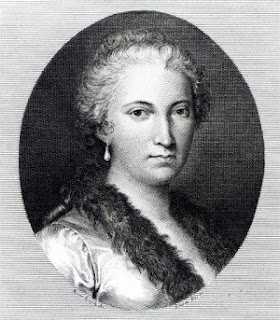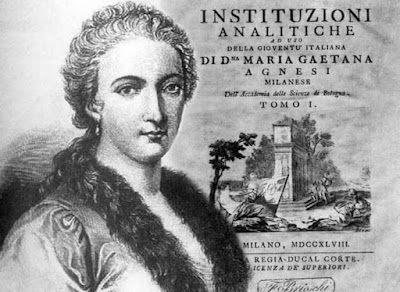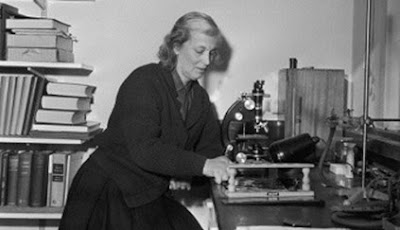Google Doodle Maria Gaetana Agnesi's 296th birtday
Four days after Dorothy Hodgkin, a British chemist, Google's doodle, celebrates the 296th birthday of the Italian mathematician and philosopher Maria Gaetana Agnesi. The Doodle showsthe Witch of Agnesi curve.
The mathematical curve named after her is achieved by drawing a line from the source through the circle of radius.
Their real-life uses were only fully recognised in the late 20th and early 21st centuries, by physicists and mathematicians working with x-rays, optical lines, and electrical circuits.
Maria Gaetana Agnesi:
Maria Gaetana Agnesi:
Gaetana Agnesi, born on 16 May 1718, to a wealthy and literate Milanese silk merchant, Agnesi was recognised as a child prodigy and became interested in mathematics and several modern languages, as well as Latin, Greek, Hebrew.
Propositiones philosophicae or “Propositions of Philosophy”, a series of essays on natural philosophy and history based on her discussions before such gatherings, was published in 1738.
Maria Gaetana Agnesi
Propositiones philosophicae or “Propositions of Philosophy”, a series of essays on natural philosophy and history based on her discussions before such gatherings, was published in 1738.
Maria Gaetana Agnesi
At an early age she composed and delivered an hour-long speech in Latin to some of the most distinguished intellectuals of the time on the subject of women’s right to be educated. Wow ! That's interesting if we think she lived in the 18th century.
Some decades before Leopold Mozart dragged his young son Wolfgang Mozartto any prince or archbishop who had half a chance of offering a decent appointment, a Milanese girl with a genius intellect was made the center of an ongoing academic circus routine by her status-hunting father.
Maria Gaetana Agnesi
Library of Congress, Washington, D.C. (digital file no. 3b09774)
Agnesi is believed to be the first woman in the west to gain recognition as a mathematician, at a time when most Europeans did not see the value of education for women.
Maria Gaetana Agnesi, remembered today only for a curve, the Witch of Agnesi, which shows up in the margins of introductory calculus texts from time to time, and which she didn’t actually discover.
Maria Gaetana Agnesi, remembered today only for a curve, the Witch of Agnesi, which shows up in the margins of introductory calculus texts from time to time, and which she didn’t actually discover.
Agnesi best-known work, Instituzioni analitiche ad uso della gioventù italiana, or the Analytical Institutions for the Use of Italian Youth, explored algebra and analysis (two volumes). In it she discusses the algebraic curve, now known as the witch of Agnesi.
After her father’s death, she apparently lost all interest in scientific work and turned to religion and devoted the last four decades of her life to studying theology and to charitable work, taking charge of a home for the poor and infirm in 1771.
Maria Gaetana Agnesi stamp
Italia, 2018
For the remaining fifty years of her life, she gave comfort to the mentally ill and elderly from 1771, and hunted the streets for children to be brought to her catechism class. The woman who had been regarded as one of the greatest minds of Italy, consulted from every corner of Europe for her advice on matters mathematical and philosophical, died unremarked on 9 January 1799.
Dorothy Hodgkin:
Dorothy Hodgkin:
On Monday, 12th May, Google Doodle celebrated Dorothy Hodgkin's 104th birthday, the British chemist.
Dorothy Hodgkin
credits: : Harold Clements / Freelancer
Hodgkin was the third woman to be awarded the Nobel Prize in Chemistry (1964) which she won for her discovery of the structure of vitamin B12 in 1964.
Dorothy Hodgkin and her husband Thomas at the Nobel ball in 1964
© The Hodgkin Family
She is the only British woman to have won the prize to date. Born in Cairo on May 12, 1910 to English parents, Hodgkin went on to study chemistry at the University of Oxford's Somerville College, before going on to earn her PhD at the University of Cambridge.
Dorothy Crowfoot Hodgkin honored postage stamp
The biochemist was best known as a pioneer in the advancement of the technique of X-ray crystallography, a method used to determine the three-dimensional structure of biomolecules.
Dorothy Hodgkin
Hodgkin's love of her work was clear, and she was quoted as saying:
"I was captured for life by chemistry and by crystals".
"I was captured for life by chemistry and by crystals".
She was also know for her contribution to the discovery of the structure of insulin and penicillin.
She returned to Oxford in 1934 and in 1936 was appointed Somerville's first fellow and tutor in chemistry – a post which she held until 1977.
She was the chair of the Pugwash Conference from 1976 to 1988, an organization inspired by a manifesto by Albert Einstein and Bertrand Russell that works to reduce harm and conflict caused by scientific discoveries (like nuclear weapons.)
Dorothy Hodgkin a life
by Georgina Ferry
She was the chair of the Pugwash Conference from 1976 to 1988, an organization inspired by a manifesto by Albert Einstein and Bertrand Russell that works to reduce harm and conflict caused by scientific discoveries (like nuclear weapons.)
Girls in science
credits: unknown
Education:
No doubt! Google loves women in science. Ada Lovelace, Rosalind Franklin, Marie Curie, Grace Hoper, Dorothy Hodgkin and today Gaetana Agnesi. And of course, women in Humanities as Hannah Arendt, Catherine Mansfield, Simone de Beauvoir among others.
The discussion of a better understanding of the role of the girls and young women dimension in many different STEM areas of study, and how these findings can lead to new ideas and new markets for girls and women in science knowledge is on the news every day.
This must begin early in school where girls must be encouraged to access to science and technology.
The aim is to encourage creativity in the field of science and new technologies and highlight the importance of developing innovative skills at an early age.
However I read on The Guardian, this week, an interesting article : Women in technology : no progress on inequality for 10 years says:
" A report by the research firm Gartner on chief information officers (CIOs) and the challenges they face in the industry has shown that the percentage of women taking the role has remained largely static at 14% since 2004, when the firm started gender analysis.
The situation in the EU is also worse than developing nations and the US, where the proportion of women in leadership roles is higher. Gartner’s data showed women occupied 11.2% of technology leadership roles in Europe, the Middle East and Africa compared with 18.1% in North America, 13.4% in Latin America and 11.5% in Asia."
Samuel Gibbs, Technology
Some thoughts:
Samuel Gibbs, Technology
Some thoughts:
All the initiatives trying to change this situation are welcome. And teachers have an important role on it by fighting inequality for girls in science.
You can begin to include Doodles of women in science into school curriculum to motivate girls.
G-S
16.05.2014
Copyright © 2014G-Souto'sBlog, gsouto-digitalteacher.blogspot.com®

Women in Science : Google doodles at school by G-Souto is licensed under a Creative Commons Attribution-NonCommercial-NoDerivatives 4.0 International License.












No comments:
Post a Comment